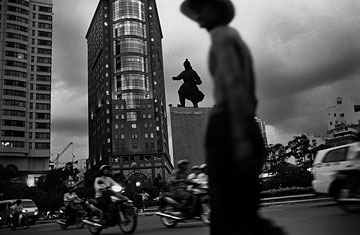
Downtown Ho Chi Minh
September 26, Phnom Penh, Cambodia
When the final Vietnamese soldiers straggled out of Cambodia in September 1989, after a decade's bloody occupation, the convoys rumbled home in rusting Soviet trucks. Army meals consisted of little more than water drawn from nearby rice paddies and cubes of pork fat. Many of the Cambodians who lined the rutted road to watch the departing soldiers were lucky to eat even that. The only constant in their mouths was the metallic taste of fear. Vietnam was desperately poor, Cambodia even poorer.
Today, the five-hour drive between the booming Cambodian capital Phnom Penh and the even more rollicking Vietnamese metropolis of Ho Chi Minh City rolls by on shining asphalt, as smooth as the relations between once bitter enemies. On the Cambodian side of the border, a cluster of factories called the Manhattan Special Economic Zone and a triumphal stand of casinos — the Caesar, the VIP, the Win — attest to the new money flooding the region. Vietnam and Cambodia are still poor, and income inequality is widening. But their economies expanded at 6.2% and an estimated 6.5% respectively in 2008 and were preceded by years of double-digit growth. Foreign countries once sent weapons; now they invest in garment factories and office towers.
In the context of the great upheavals of 1989, the ebb of a distant war between Cambodia and Vietnam might feel like a historical footnote. But this conflict, the only sustained war between communist countries, represented the climax of Cold War geopolitical machinations that directly claimed tens of thousands of lives in Indochina. A decade before, Vietnam, supported by the Soviet Union, invaded its neighbor ostensibly to free the country from the Khmer Rouge, which presided over the deaths of up to one-fifth of the Cambodian population. The Khmer Rouge, backed by Beijing, had invited trouble when they made incursions into southern Vietnam in a deluded effort to seize what centuries ago had been Cambodian territory. After the Vietnamese swept away the Khmer Rouge from Phnom Penh, a puppet regime was installed. But a bloody drip-drip of combat between Vietnamese soldiers and Khmer Rouge guerrillas prevented either country from contemplating a future of peace or prosperity.
A series of meetings in Jakarta and Paris in 1989 cobbled together an unlikely détente between warring Cambodian factions and Hanoi. When the Vietnamese pulled out of Cambodia, it not only signaled the decline of socialist fervor in Southeast Asia; it also unleashed an economic transformation that has uplifted millions. "Only after the withdrawal could we see the light at the end of the tunnel in terms of our economy and foreign relations," says Huynh Buu Son, a Vietnamese former state banker. "This was a turning point for Vietnamese history — and for the region."
For years after the Vietnamese quit Cambodia, the upturned earth near the international airport in Phnom Penh was still known as the Place of Vietnamese Corpses. By the Vietnamese army's own reckoning, its occupation of Cambodia resulted in 25,300 Vietnamese deaths. The soldiers' bodies were eventually repatriated from Phnom Penh, but the vast plot lay unused afterward. It was a place, people whispered, of restless ghosts. Then, as a building boom struck the Cambodian capital, the local Canadia Bank snapped up the Place of Vietnamese Corpses and redeveloped it as a housing estate. Duong Bela, a former conscript in the Cambodian army who served the Vietnamese occupiers, is one of the proud homeowners. He's not worried about any ghosts in his new home. "That was a long time ago," he says. "We've all moved on."
So has neighboring Vietnam. Around the time Hanoi was readying to pull out of Cambodia, Son, a native of Saigon — as locals still refer to what was renamed Ho Chi Minh City — was busy resuscitating the Vietnamese economy. After 14 years of socialist experimentation, the country's planned economy had unraveled. Son drafted the country's first banking reform and was feted in Paris and Washington for his economic derring-do. "It was time to change," recalls Son. "Everyone knew it."
The same year, Son and other reformers submitted a plan for socialist Vietnam's first foreign-investment zone. The formation of the Tan Thuan Export Processing Zone was predicated on Vietnam quitting Cambodia, since a withdrawal was a precondition for many countries normalizing economic relations. Today, 30,000 Tan Thuan workers, on the outskirts of Ho Chi Minh City, churn out everything from bridal gowns to circuit boards for export to Germany, Australia, the U.S. and elsewhere.
These days, it is Ho Chi Minh City that has been invaded — by Marc Jacobs and Cartier and Gucci. Their boutiques preen on streets where bedraggled North Vietnamese troops once marched into town. Despite a property downturn, nearly everything in Vietnam's financial capital seems on the brink of demolition for something newer or bigger or taller. Driving the streets, Bui Quang Sac complains that almost nothing is where it used to be — a sense of disorientation is practically the only constant in this changing city. When he was 18, Sac was drafted to fight in Cambodia. On the way to the front lines, he fled. A dozen of his platoon of 40 perished. Sac ended up in a re-education camp for two years for his army desertion. "But at least I lived," he says, weaving through a dense traffic of cars, trucks and a fleet of motorcycles laden with entire families. For those Vietnamese and Cambodians who made it past 1989, just surviving was an accomplishment. Now the real living has begun.